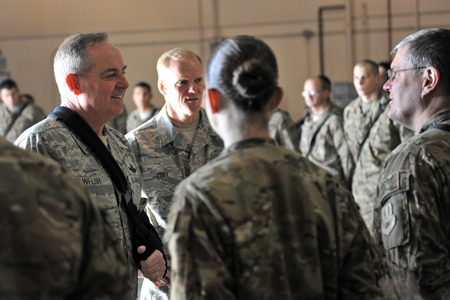While  Air Force leaders were determined to attack the problem of declining readiness levels in the service’s Fiscal 2013 and Fiscal 2014 budgets, the coming across-the-board spending cuts known as sequestration will ensure that doesn’t happen, said Chief of Staff Gen. Mark Welsh on Feb. 13. Unless Congress acts to stop sequestration, it will kick in on March 1. Already today, nearly one half of the Air Force’s fighting-level units “are below what I would consider an acceptable combat-readiness level,” Welsh told the House Armed Services Committee just one day after issuing a similar warning to a Senate oversight panel. The high operational tempo over the last decade of conflicts in Iraq and Afghanistan has degraded equipment and prevented the Air Force from modernizing its fleet—a risk service leaders considered “acceptable” while the nation was at war, he said. However, such risk is no longer acceptable, said Welsh. “The problem as I see it,” he explained, is that “when the next major conflict starts, we will send our joint force to fight regardless of how ready they are. And, they will go. And, they will fight. And, they will die in greater numbers than they have to.” He continued, “We owe them better than that.” (Welsh’s written testimony)
Air Force leaders were determined to attack the problem of declining readiness levels in the service’s Fiscal 2013 and Fiscal 2014 budgets, the coming across-the-board spending cuts known as sequestration will ensure that doesn’t happen, said Chief of Staff Gen. Mark Welsh on Feb. 13. Unless Congress acts to stop sequestration, it will kick in on March 1. Already today, nearly one half of the Air Force’s fighting-level units “are below what I would consider an acceptable combat-readiness level,” Welsh told the House Armed Services Committee just one day after issuing a similar warning to a Senate oversight panel. The high operational tempo over the last decade of conflicts in Iraq and Afghanistan has degraded equipment and prevented the Air Force from modernizing its fleet—a risk service leaders considered “acceptable” while the nation was at war, he said. However, such risk is no longer acceptable, said Welsh. “The problem as I see it,” he explained, is that “when the next major conflict starts, we will send our joint force to fight regardless of how ready they are. And, they will go. And, they will fight. And, they will die in greater numbers than they have to.” He continued, “We owe them better than that.” (Welsh’s written testimony)
Air Force Gen. Alexus G. Grynkewich assumed command of U.S. European Command on July 1, taking over the key assignment as the U.S. and its allies contend with a resurgent Russia and a grinding war in Ukraine.
